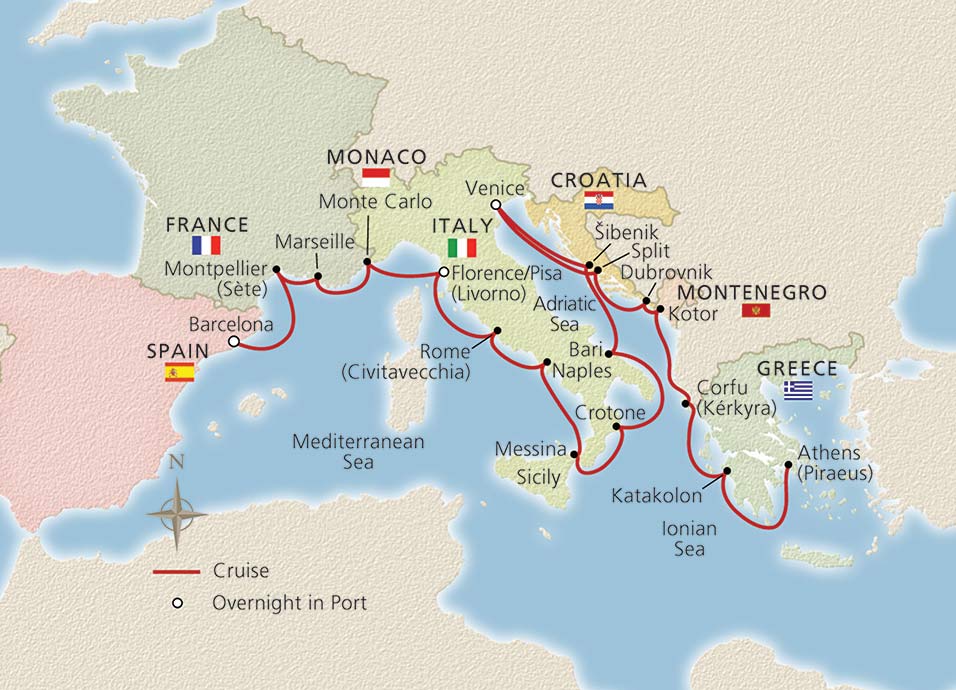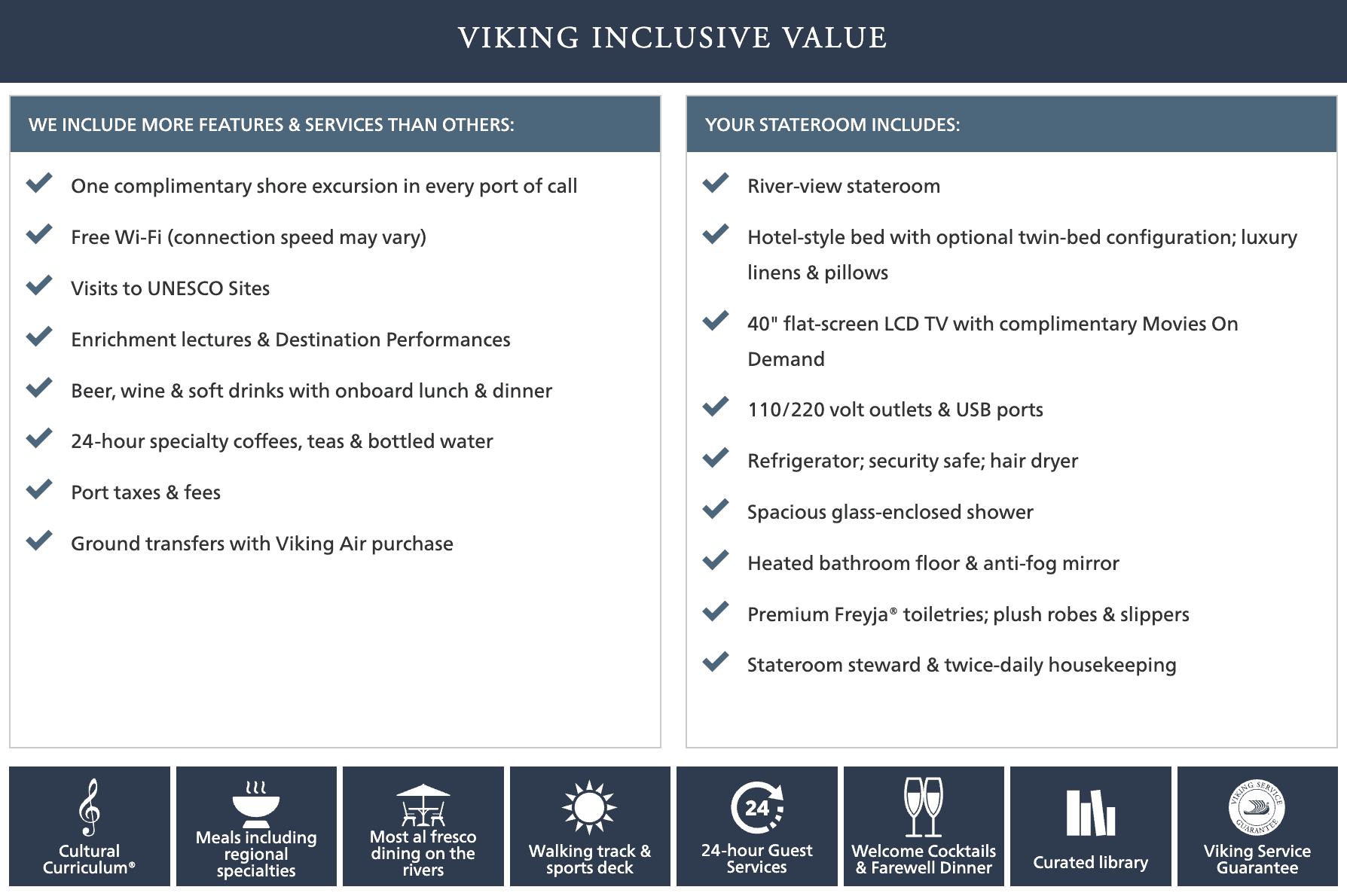Call us or email us if you have any questions.

Span the Mediterranean
Combine Venice, the Adriatic & Greece, Italian Sojourn and Iconic Western Mediterranean for a comprehensive 22-day voyage. From ancient Athens and Croatia’s stunning Dalmatian coast to the rustic shores of Italy and the glamorous French Riviera, you will immerse yourself in rich cultures and traditions and marvel at spectacular coastal beauty. Overnight stays in Venice, Florence/Pisa and Barcelona help you delve more deeply into this historic and legendary region.

Athens, Greece / Barcelona, Spain
2024 Sailings on May, on July, and from September to October
2025 Sailings on January, and from March to August
* Please check with us for dates & pricing
Cruise fare from $10,799.0 per person
* Please check with us for dates & pricing

Step on board in Athens, where you will have an entire day to explore this ancient city. Perhaps you will see the Hellenic Parliament, Constitution Square, the Panathenaic Stadium, the Temple of Zeus or the iconic Acropolis. Explore the bustling Plaka District at the base of the Acropolis. Tonight we set sail for Olympia.
Visit the quaint Greek port of Katakolon, huddled around a pretty little harbor dotted with colorful fishing boats. During your visit, venture into the fertile valleys of the western Peloponnese to the legendary city of Olympia, classical birthplace of the modern-day Olympic Games on the slopes of Mt. Kronos. Walk among the ancient city’s ancient ruins with an expert guide and historian, admiring the remains of temples, the Palaestra, or wrestling school, and the Gymnasium. You will gain insight into the very first Olympic Games at the fascinating museum.
Corfu has a rich history shaped by conquerors and by royalty seeking tranquility. Corfu’s Old Town and Fortress—fashioned by the once powerful Venetian Republic—comprise a UNESCO World Heritage Site. Its narrow warrens lead to one of Europe’s largest public squares and a lovely promenade once exclusively reserved for the local aristocracy. Everywhere, magnificent coastal views unfold and scenic byways lead to history-rich enclaves, from the archaeological site of Paleopolis and the stunning Vlacherna Monastery to a former Greek royal villa.
Spend the day traversing the medieval streets of this historic Montenegro town with a walking tour. Pass by Venetian walls constructed in 1420 en route to the Cathedral of St. Tryphon, built in 1166. Notice its mismatched towers, the result of an earthquake and a budget too small to rebuild properly. Included on this tour is a visit to the Maritime Museum, which documents Kotor’s heritage. As an option, venture to the small towns of Budva and Sveti Stefan, the latter once a hideaway for the rich and famous.
Dubrovnik is a historic jewel, with its spectacular Adriatic setting, 12th-century medieval streets and incredibly preserved structures. So stunning is its Old Town, the playwright George Bernard Shaw famously called it “paradise on Earth.” It is all spectacularly surrounded by a towering medieval wall. Inside, the ancient city’s Stradun is lined with authentic stone houses. The peaceful 14th-century Franciscan Monastery and Apothecary, housing the world’s oldest working pharmacy and fine collection of Renaissance paintings, provide insight into the ages.
Built around the Roman Palace of Emperor Diocletian, Split is one of Croatia’s oldest cities. Its promenade commands majestic views over a bay and the Adriatic Sea. Despite evidence of Split’s origins in the 6th century BC, the city is traditionally considered over 1,700 years old—counting from the construction of the palace. Its well-preserved remains have been seamlessly assimilated into the modern city. An Ethnographic Museum is found at the palace’s heart and shops line the passageways of its ancient basement. Diocletian’s ancient mausoleum is now a stunning cathedral.
Chioggia is a charming fishing community steeped in its age-old seafaring traditions. It is also the gateway to Venice, famed for its wondrous patchwork of graceful piazzas, tranquil canals, artful footbridges and Gothic splendor. All things Venetian begin in St. Mark’s Square, where its elegant campanile, or bell tower, rings over the rooftops, and the Byzantine-Gothic St. Mark’s Basilica seems to preside over all. Beyond St. Mark’s and away from the crowds, Venice is a hushed and intriguing city to explore on foot, with medieval echoes marking every step.
The Venetian Republic ruled Adriatic waves for a millennium. During the 8th century as the Roman Empire began to decline, many Europeans fled to Venice and its neighboring towns, including Chioggia. Merchants put their skills to use, and the city-state was soon thriving. The Venetian Lagoon’s canal banks feature buildings influenced by Byzantine and Islamic architecture, reflecting Venice’s powerful trading network. The first vaporetto traversed the Grand Canal in 1881; alongside the gondolas, these iconic Venetian water buses are at the heart of Venice’s transport network.
Part of the Venetian landscape for centuries, the gondola was once the city’s primary form of transport. During the 1500s, some 10,000 crafts plied the canals. The flat bottom was designed for the shallow depths of the Venice Lagoon, and its narrow width allowed the gondolier to achieve greater speed and maneuverability. Today, a few public gondolas serve as traghetti, or ferries, conveying people across the Grand Canal, while several hundred, painted black by local law, usher explorers into narrow canals, piloted by capped gondoliers in iconic striped shirts.
Cruise the scenic St. Anthony Channel into the oldest Croatian city on the Dalmatian Coast, Šibenik. Resting at the mouth of the Krka River, this UNESCO World Heritage Site has a remarkably preserved Old Town. Roam its narrow streets past medieval houses and churches, all surrounded by four historic fortresses. The city’s St. James Cathedral is the most important Renaissance structure in Croatia. Perhaps you will join an excursion to view the impressive waterfalls of the Krka River.
Explore sunny, palm-lined Bari, where streets are lined with romantic, honey-toned balconied houses, welcoming courtyards and Romanesque and baroque churches. Visit the Norman-Swabian castle, the splendid Romanesque Basilica of St. Nicholas and the Petruzzelli Theater, one of Italy’s most important opera houses, and stroll the picturesque waterfront. Or perhaps visit Alberobello and its fascinating trulli houses, a UNESCO World Heritage Site of whitewashed buildings with conical roofs.
Uncover the deep past of Crotone, founded as a Greek colony in 710 BC. Boasting a vast array of archaeological relics, the city was once heralded as the home of some of the Hellenic Empire’s most celebrated figures, including many victors of the Olympic Games and Pythagoras, whose mathematical theories altered Western thought. During your visit, marvel at the impressive cathedral, a neoclassical wonder, browse the Pythagoras Museum and Gardens, and explore the waterfront and Crotone castle.
Sicily has been shaped by countless civilizations, from Greek to Byzantine to Roman. When it fell under Spain’s purview in the 17th century, it was celebrated as one of Europe’s ten great cities. Surrounded by undulating mountains, orange and olive groves and vineyards are plentiful. During World War II, Messina was the destination of the unofficial “Race to Messina” between US General Patton and British Field Marshall Montgomery. In the end, Patton arrived just hours before his British comrade, receiving credit for securing Sicily.
Naples boasts a long history in a stunning seaside setting and is known mostly for its pizza. The city has long been a major center of Italian culture and was the seat of a powerful independent kingdom for 500 years. So great was its sway that it lured the region’s finest architects and artists. In the grand Piazza del Plebiscito, the grand and sweeping public square, the San Francesco di Paola Church flaunts a colonnaded facade reminiscent of the Pantheon in Rome, and the Royal Palace overlooks Neapolitans with statues of all the kings of Naples peering out from alcoves.
For centuries, Rome ruled much of Europe, building a vast empire from the power of emperors. More than 2,500 years of history live in the city’s streets. Ancient structures recall those heady days when the cheers of 80,000 spectators roared from the Colosseum, citizens mingled in the Forum and senators asked the gods for guidance at the Pantheon. Along with the Vatican and St. Peter’s Basilica, this rich pocket of Italy is one of the world’s greatest repositories of history and civilization.
Tuscany is known for its scenic beauty and exudes a unique, rustic character. Vineyards, olive tree groves, wheat fields and endless expanses of farmland skirt the bases of medieval hill towns as they march across an undulating landscape of gentle hills. Fertile soils produce some of the world’s finest wines, including Chianti and Vino Nobile di Montepulciano. More than this, many consider Tuscany the birthplace of the original farm-to-table movement. Simple, honest food graces the Tuscan table, from creamy cheeses to thick Florentine steak grilled over a wood fire.
Tuscany is known equally as the cradle of the Renaissance and a center of culinary delights and astounding wines. Throughout this emerald-green countryside dotted with cypress trees, endless delights unfold. Among them is Florence, a living museum of the Renaissance. Brunelleschi’s famous Duomo dominates the medieval cityscape—an architectural achievement. Another Tuscan treasure, the Square of Miracles, unfolds in Pisa. Here, a trinity of masterpieces—the Leaning Tower, Pisa Cathedral and Baptistery—comprise some of Europe’s finest art and architecture.
The chic city of Monte Carlo in the petite kingdom of Monaco boasts some of the world’s most exclusive shopping and a beautiful old port. A fairy-tale aura has settled on this glittering city of the Grimaldi family, perhaps nowhere more elegantly than at the Prince’s Palace, where the late American actress-turned-princess Grace Kelly presided with Prince Rainier III. Monte Carlo’s medieval quarter perches on “The Rock,” an escarpment at the foot of the Maritime Alps, and offers spectacular views of the Mediterranean and the harbor lined with mega-yachts.
Marseille is rich in historic treasures, nestled between the Mediterranean and rocky hills of limestone. Two 17th-century fortresses dominate the charming Vieux Port, or Old Port, the natural harbor that hosts all manner of watercraft, from sleek elegant yachts to old style fishing vessels. Its picturesque quay is one of the world’s most romantic walks, lined with dozens of cafés and shops. Also worth exploring is the city center, graced by La Canebière boulevard. Linger in a café and sample the city’s signature bouillabaisse made from freshly caught fish.
Explore Montpellier today, a center of learning for centuries. Its namesake university, founded in 1160, is one of the world’s oldest, predating the Renaissance. The social and cultural center of Montpellier is the Place de la Comédie, anchored by the elegant Three Graces fountain and the stunning, neoclassical Opéra Comédie. Other sites pay tribute to a rich heritage, from the art-filled Musée Fabre and impressive St. Clement Aqueduct to the St. Pierre Cathedral with its “floating” porch supported by a pair of towers.
Discover the best of Barcelona as you visit the Columbus Monument, Port Vell and the Arc de Triomf, among the many monumental sights you will see. Other scenic highlights include the Olympic Port, built for the 1992 Olympic Games, and the Passeig de Gràcia, a gracious boulevard renowned for its architecture, including stunning works by Gaudí.
Barcelona is steeped in history, with stunning architecture and a rich culture. Mediterranean breezes grace the shore and Catalonia’s capital is a feast for the senses. Long strolls on wide boulevards—such as Las Ramblas, the mile-long leafy pedestrian way, and the Passeig de Gràcia, lined with some of Europe’s most elegant buildings—set the tone for a city that moves to its own tempo. Native son and famed architect Antoni Gaudí adorned his city with whimsy, whether along fantastical city blocks or with his colossal masterpiece, the towering La Sagrada Família cathedral.
* One shore excursion included per port; all others available at an extra charge.